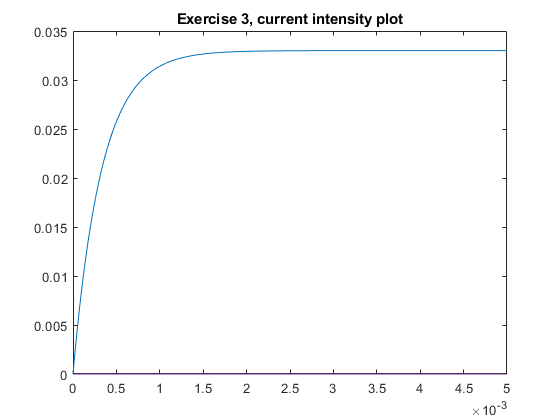Lab 1 homework, Ioan Dragomir
Process Modeling, prof. Daniel Moga, Technical University of Cluj-Napoca
Introduction to MATLAB. Implementing various mathematical functions (with branches, loops, and a simple electrical circuit) and plotting them.
Contents
Overview of called functions:
plot_ex1_1; plot_ex1_2; plot_ex1_3; check_ex2; plot_ex3;
Exercise 1
Write functions to plot the following signals:
1. \( y = \begin{cases} -t, &t \in [-4, 0) \\ t, &t \in [0, 4] \end{cases} \)
function y = ex1_1(t) if t >= -4 && t < 0 y = -t; elseif (t >= 0 && t <= 4) y = t; end end function plot_ex1_1 t = -4 : 0.01 : 4; y = arrayfun(@(x) ex1_1(x), t); % What awful syntax... Can't I just % declare that the function takes in a % scalar and have it automagically % vectorize ex1_1(t) for me, as it does % in, say, sin(t)? Or must each % function implement this internally % and sin() has this arrayfun logic % applied after entering the function, % not by the language beforehand? plot(t, y); title("Exercise 1, top left formula"); end
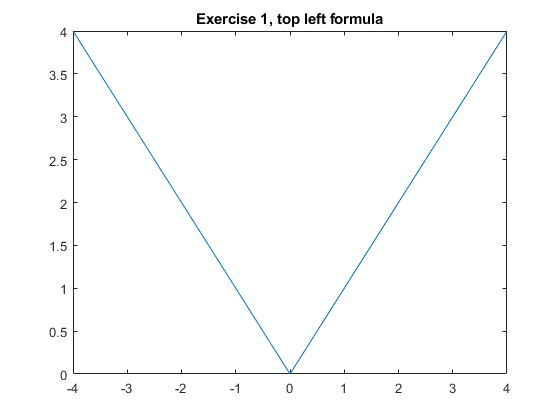
2. \( y = 0.5^t,\quad t \in [0, 10] \)
function y = ex1_2(t) if t >= 0 && t <= 10 y = 0.5^t; end end function plot_ex1_2 t = 0 : 0.01 : 10; y = arrayfun(@(x) ex1_2(x), t); plot(t, y); title("Exercise 1, top right formula"); end
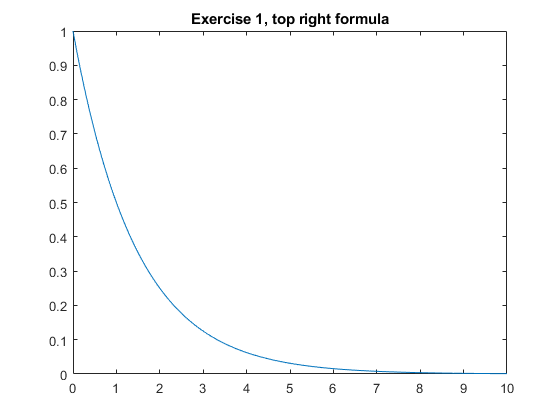
3. \( y = \begin{cases} \sin(t), &\{-10 \leq t \le 4\} \cup \{4 \le t \le 10\} \\ \cos(5t), &-4 \le t < 4 \end{cases} \)
function y = ex1_3(t) if (t >= -10 && t < -4) || (t >= 4 && t <= 10) y = sin(t); elseif t >= -4 && t < 4 y = cos(5*t); end end function plot_ex1_3 t = -10 : 0.01 : 10; y = arrayfun(@(x) ex1_3(x), t); plot(t, y); title("Exercise 1, bottom formula"); end
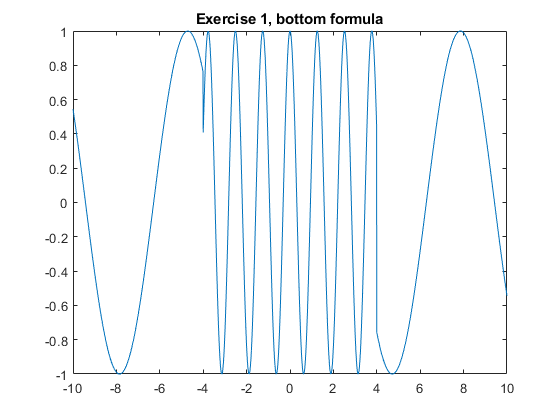
Exercise 2
Write a function for computing the factorial of a number n ( \( n! \) )
function nf = factorial(n) nf = 1; for i = 1:n nf = nf * i; end end function check_ex2 assert(factorial(1) == 1) assert(factorial(3) == 6) assert(factorial(5) == 120) disp("No assert errors => Factorials are OK!"); end
No assert errors => Factorials are OK!
Exercise 3
Consider a model for an electric circuit which contains a resistor, an inductor, a continuous voltage source and a switch, in series.
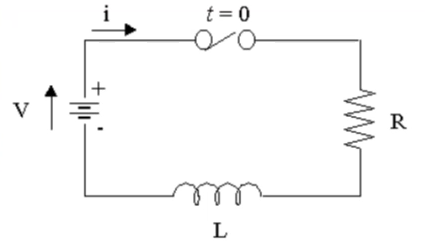
If at time \( t = 0 \) the switch is turned on (prior to this moment the current in the inductor is zero), the following equation is valid:
\[ L \frac{di}{dt} + Ri = V \]
Show that the solution to this equation is:
\[ i = \frac{V}{R}(1-\exp(-Rt/L)) \]
My solution is as follows. First we rearrange the terms to get the usual Linear Differential Equation form (1), then follow through with the usual LDE trick of creating a differential of a product and integrating it (2, 3, 4), to get a non-differential equation which we can solve algebraically (5, 6, 7).
\[ \begin{align} \frac{di}{dt} + i \frac{R}{L} &= \frac{V}{L} &|& \cdot e^{\int \frac{R}{L} dt} = e^{\frac{Rt}{L}} \\ \frac{di}{dt} e^{\frac{Rt}{L}} + i \frac{R}{L} e^{\frac{Rt}{L}} &= \frac{V}{L} e^{\frac{Rt}{L}} &|& a'b + ab' = (ab)' \\ \frac{d}{dt}(i \cdot e^{\frac{Rt}{L}}) &= \frac{V}{L} e^{\frac{Rt}{L}} &|& \int \ldots dt \\ \int\frac{d}{dt}(i \cdot e^{\frac{Rt}{L}}) dt &= \int \frac{V}{L} e^{\frac{Rt}{L}} dt && \\ i \cdot e^{\frac{Rt}{L}} &= \frac{V}{L} \cdot \frac{L}{R} e^{\frac{Rt}{L}} + C &|& \cdot e^{-\frac{Rt}{L}} \\ i &= \frac{V}{R} (e^{\frac{Rt}{L}} + C) e^{-\frac{Rt}{L}} && \\ i &= \frac{V}{R} (1 - C\cdot\exp(-Rt/L)) && \\ \end{align} \]
With this general form, we use the fact that \( t = 0 \Rightarrow i = 0 \) to get \( C = 1 \), thus confirming the solution for \( i(t) \):
\[ i = \frac{V}{R}(1-\exp(-Rt/L)) \]
function i = sim_circuit(t, V, L, R) i = V / R * (1 - exp(-R * t / L)); end function plot_ex3 V = 3.3; R = 100; L = 33e-3; t = 0 : 1e-5 : 5e-3; i = zeros(length(t)); % instead of [] so it won't complain abt resizing for ti = 1:length(t) i(ti) = sim_circuit(t(ti), V, L, R); end plot(t, i); title("Exercise 3, current intensity plot"); end
